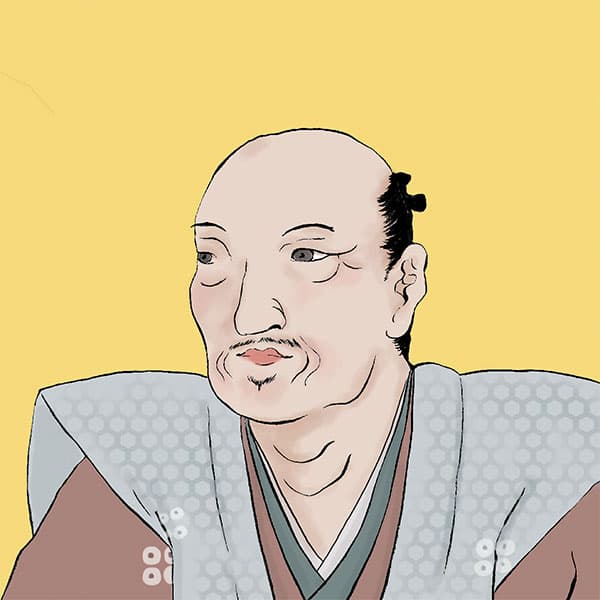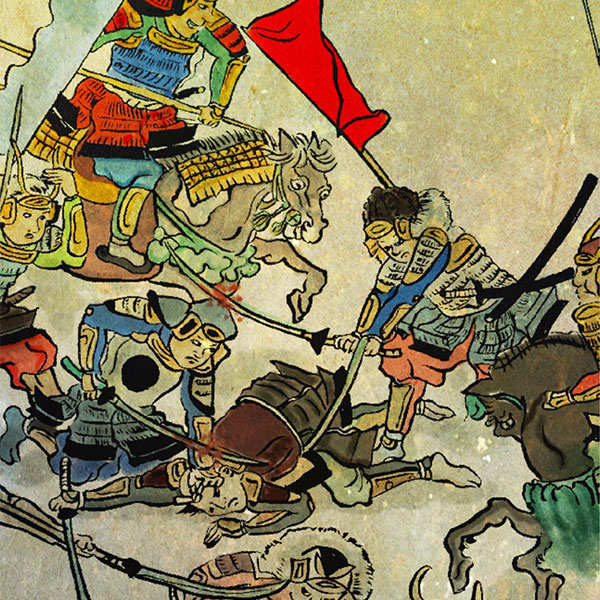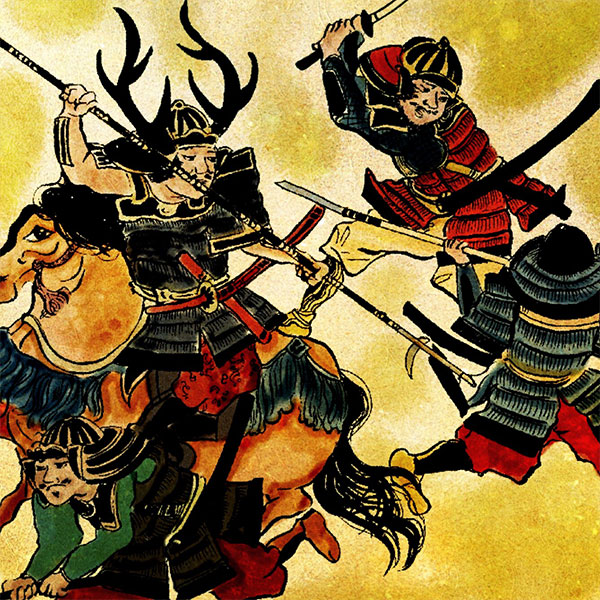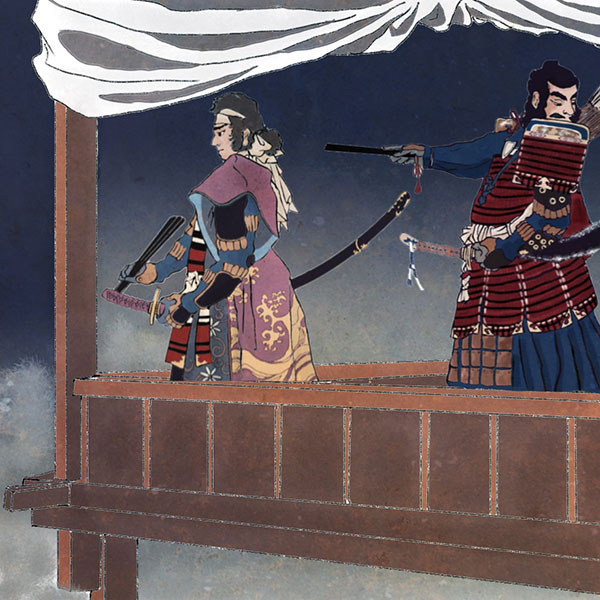Yukimura Sanada (2/2)The best soldier in Japan (Hinomotoichi no Tsuwamono)

Sanada Yukimura
- Article category
- biography
- name
- Sanada Yukimura (1567-1615)
- place of birth
- Nagano Prefecture
- Related castles

Ueda Castle

Oshijo
In 1615, the peace between the Toyotomi family and the Tokugawa family was broken. There will be another battle at Osaka Castle, the Summer Siege of Osaka.
Since the moat of Osaka Castle was filled in by the Tokugawa family, the Toyotomi family decided to actively attack.
Yukimura participated in the Battle of Domyoji in Kawachi Province. Date Masamune's troops are temporarily forced to retreat after a gunfight. However, in the battle at Domyoji, the generals of Osaka's side were killed, and they were at a disadvantage. Here, Yukimura served as a lord, defeating the approaching Date family army and successfully evacuating the Toyotomi family.
Returning to the castle, Yukimura planned the final strategy with the Osaka generals and proceeded with the army.
However, the operation ended in failure, and the generals of the Osaka side became isolated.
Yukimura, prepared for death, made a desperate charge, aiming only at Tokugawa Ieyasu's headquarters.
This charge was not only carried out by Yukimura's army, but also generals from the Osaka side, who fought bravely along the entire line, putting the Tokugawa forces at a disadvantage.
The Sanada army, commanded by Yukimura, broke through the Tokugawa army and arrived in front of Ieyasu's headquarters. Furthermore, he dared to charge towards Ieyasu's headquarters. The soldiers surrounding Tokugawa Ieyasu were also overrun, and it is said that Ieyasu was twice prepared to commit suicide due to the ferocity of Sanada's attack.
However, each time they attacked, their soldiers were killed, and they were finally forced to retreat. The Osaka side, which had continued to attack, completely collapsed and began retreating to Osaka Castle, and the defeat of the Osaka side became decisive.
Yukimura was found by a samurai of the Echizen Matsudaira family as he rested his injured and tired body against a tree in the precincts of Yasui Shrine (Tennoji Ward, Osaka City) near Shitennoji Temple, and was told, ``Take credit for this head.'' He was killed with these last words: He passed away at the age of 49.
During the Summer Campaign in Osaka, Sanada Yukimura invaded Tokugawa Ieyasu's headquarters and fought a lion-like battle, which is recorded in the historical materials of the Edo shogunate and various feudal lords. From then on, he came to be known as ``Japan's best soldier'' (Hinomoto Ichi no Tsuwamono).
Origin of Yukimura Sanada
Yukimura Sanada is known by the name "Yukimura," but the correct name is "Nobushige." Even in his handwritten letters and other historical materials, there is no mention of the name ``Yukimura.''
So, how did the name "Yukimura" become so popular?
The name ``Yukimura'' began to be used around 60 years after Osaka's role.
For the first time in the story, Masayuki Sanada's second son is mentioned as ``Saemon Sae Yukimura'' or ``Sanada Saemon Jo Umino Yukimura.''
I don't know why the name ``Nobushige'' became ``Yukimura,'' but one theory is that ``Sachi'' was added to the name by the head of the Sanada family for generations.
Regarding ``mura'', there is a theory that it was taken from Muramasa, a sword that brought bad luck to the Tokugawa family, and another theory that it was taken from ``mura'' of Date Tsunamura, the lord of the Sendai domain, which Yukimura's descendants served.
However, the name ``Yukimura'' became widely known during the mid-Edo period, and in Tokugawa Mitsukuni's late linguistic book ``Togen Reiji,'' the editor wrote that ``Yukimura'' was incorrect and ``Shingo'' was correct (although ``Shingo'' was correct). It was so widely circulated less than 100 years after Yukimura's death that it was written that ``Nobushige'' was the correct answer and ``Nobushige'' was the correct answer.
As time progressed further, the name ``Yukimura'' became so established that it was even used in genealogical documents from the Edo period and official documents of the Sanada family of the Matsushiro domain.
However, the Sanada family of the Matsushiro domain seemed to be aware that the name ``Yukimura'' was incorrect and ``Nobushige'' was correct, and when they received an inquiry from the Edo shogunate about Yukimura's name, they answered ``Nobushige.'' He replied that ``Yukimura'' was the name he took after playing the role of Osaka.
In this way, Masayuki Sanada's second son, Nobushige Sanada, was popular among the common people throughout the Edo period, but his name was changed to Yukimura Sanada.
Places related to Nobuyuki Sanada
- Sanada Museum in Kishu Kudoyama
- Kudoyama Town (Kudoyama Town, Ito District, Wakayama Prefecture) is the village where Yukimura Sanada, who was defeated in the Battle of Ueda during the Battle of Sekigahara, retired with his father Masayuki Sanada.
In the village, the Sanada Museum has been created to tell the story of father and son Yukimura Sanada and Yukimura's son, Daisuke Sanada, and holds exhibitions there. The lives of the three generations of the Sanada family are introduced through costumes and props used in the drama, as well as panel displays and drama adaptations. - Sanada-an (Zenmei-in) in Mt. Kudo, Kishu
- In Kudoyama-cho, Sanada-an (Zenmei-in) was built on the site of the Sanada mansion where father and son Sanada lived.
Once you pass through the gate with Rokumonsen engraved on it, you will find the grave said to be Masayuki Sanada, the ``Lightning Well'' where Sanada Yukimura saved the villagers by trapping the lightning that struck him, and the Sanada family connection. There are museums, etc. - Kishu Kudosan Sanada Festival
- Kudoyama-cho is known as the place where father and son Sanada lived and is loved. To honor the Sanada father and son, the Kishu Kudosan Sanada Festival is held every year for two days in May. The main event is the Sanada warrior procession on the second day, which parades through the town from the roadside station to Sanada-an.
- Sanko Shrine and Sanada loophole and bronze statue
- Sanada Maru was built by Yukimura Sanada at Osaka's winter camp. The Sanada Maru was located in the area that is now Tennoji Ward, Osaka City, and today, Sanadayama is located where it was. Sanko Shrine is located near Mt. Sanada. At these three shrines, it is said that Yukimura Sanada dug a loophole from Osaka Castle to this place during the Osaka Siege, and there is a statue based on Sanada Yukimura and the ``Sanada Loophole'' that remains below the shrine building.
- Sanadayama Sanko Shrine and Sanada Festival
- Sanko Shrine holds the Sanada Festival every November in memory of Yukimura Sanada. The Sanada Loophole in the shrine grounds is open to the public, children can try out armor, a ninja show named after Sanada, and a gun shooting experience.
Sanada Yukimura and Ueda Castle
Ueda Castle is a Japanese castle located in Ueda City, Nagano Prefecture. It was a flat castle built in 1583 by Sanada Yukimura's father, Sanada Masayuki.
At the Battle of Sekigahara, Sanada Yukimura and his father, Masayuki, lined up Rokumonsen flags, symbolizing a life without sacrifice, and holed up in Ueda Castle, fought to stop Hidetada Tokugawa, and won. As a result, it was destroyed by the Tokugawa family who won the Battle of Sekigahara in the following year, 1601.
Ueda Castle is now Ueda Castle Ruins Park, with the Ueda Castle ruins at its core, and is a place of relaxation for citizens, with rows of zelkova trees said to be 100 years old and about 1,000 cherry blossom trees.
Sanada Shrine, located on the ruins of the main enclosure, is said to be the castle that did not fall during the Battle of Ueda, and is a popular spot for students to pray for victory.
Reread Yukimura Sanada's article

- WriterTomoyo Hazuki(Writer)I have loved history and geography since my student days, and have enjoyed visiting historical sites, temples and shrines, and researching ancient documents. He is especially strong in medieval Japanese history and European history in world history, and has read a wide range of things, including primary sources and historical entertainment novels. There are so many favorite military commanders and castles that I can't name them, but I especially like Hisashi Matsunaga and Mitsuhide Akechi, and when it comes to castles, I like Hikone Castle and Fushimi Castle. Once you start talking about the lives of warlords and the history of castles, there's a side of you that can't stop talking about them.








